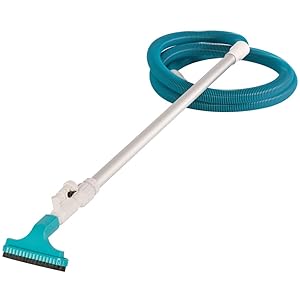Pond vacuums are a helpful tool for keeping our ponds and fountains clean. All kinds of natural and man-made debris collect and settle in our koi ponds, water gardens, fountains and birdbaths.

Most of the stuff we want to remove is natural organic matter. Even in clean-looking ponds there is a continuous collection of fine particulate debris settling onto the bottom. Dead algae cells, plant fragments, solid fish waste and uneaten fish food form a rotting sludge layer in ponds and water gardens. Soil that spills over from potted plants and washes in from the lawn adds to this muck layer.
Even with a powerful pond filtration system this sludge layer will form a thick layer on the bottom. If not removed, the organic sludge becomes a breeding ground for disease-causing organisms that can cause fish health problems. Decomposing sludge also releases algae-promoting nutrients like phosphate along with hydrogen sulfide (rotten egg) gas.
Tree leaves, especially in the Fall, will add to this problem. Ornamental fountains also collect organic material from dead algae and leaves that blow into the water. Bird waste will foul the water and stimulate unsightly algae growth, even if the water has been treated with algae-control chemicals.
What is a pond vacuum?
What are the benefits of vacuuming my pond?
It is not necessary to have a “spotless” pond. A few leaves and even a thin layer of sludge is not harmful. However, a build-up of organic debris will consume dissolved oxygen, robbing it from the fish and other pond life.
Decomposing organic matter is rich in nutrients like phosphate and nitrate and will release it into the water. This just feeds the algae and can stimulate green-water blooms in the water.
This sludge layer can be re-suspended by fish, waterfalls, aeration systems and anytime you move a potted plant, causing cloudy water. The suspended matter clouds the water and speeds the clogging of your pond filter.
Periodic pond vacuuming greatly reduces the build-up of sludge and organic debris. The water will stay clear and clean and you’ll probably have less algae problems.
What to look for in pond vacuums
Pond vacuums are available as electric-powered or water powered.
The electric models used their on-board water pump to suction out the solids and water.
Water-powered vacuums rely on the pressure of a garden house to create a vacuum.
The freshwater from the garden house creates a negative pressure in the suction wand. This draws up water and debris, which is sent out of a hose that lays in the yard. Water-powered pond vacuums send freshwater and pond water to the outflow for watering the lawn, shrubs or garden.
The amount of suction depends on the water pressure of the garden hose. If you have lower water pressure the suction power won’t be very strong.
Here are a few other features to check out when shopping for a pond vacuum:
- Wand length determines how deep you can reach and if you’ll have to bend over to reach the bottom.
- Suction hose length determines how far you can walk away from the main filter unit.
- Accessories make it easier to reach into tight spots, scrub rocks and waterfalls.
- If large, does the vacuum have wheels to help in transport?
Best Rated Pond Vacuums Roundup
1. Oase Pondovac 5
The Oase PondoVac 5 takes the best features of the previous model and makes them even better.
The 1800-watt suction pump uses a patented two-chamber system that allows for non-stop vacuuming even while the dirty water and debris are being flushed from the collection tank.
It comes with a 16-foot suction hose and 33-foot discharge hose for easy pond cleaning.
Four suction nozzles are included: variable universal nozzle, special string algae nozzle, flat nozzle with rubber lip and crevice nozzle.
A suction control valve makes it easier to reduce suction power if necessary (shallow water), to reduce water intake.
The hose comes with strong quick-disconnect fittings for easy set-up and storage.
This model has larger 6-inch wheels for easy maneuverability.
Pros
- Non-stop cleaning.
- Aluminum wand.
- Clear wand section for monitoring suction.
- Powerful suction.
- Long discharge hose.
- Has a filter bag for capturing large debris.
- 2-year warranty.
Cons
- Almost twice as heavy as the PondoVac 4.
2. Matala Power-Cyclone with Dual Pump System
The Power Cyclone is a two-motor vacuum system.
The suction motor will vacuum up to 1500 gallons per hour.
The second one-horsepower discharge pump sends water to a discharge hose.
The pump is powerful enough to send the discharge water up to 18 feet in elevation.
This means the dirty water can be sent uphill to a drain or be used to water plants.
The two pumps operate in unison so you don’t have to periodically stop and pump out the filter canister.
Larger solids are captured in a filter bag inside the canister tank. The unit comes with a six-foot suction extension, 26 feet of suction hose and 32 feet of exhaust hose. Four cleaning heads that make it easy to scrub and vacuum every corner of the pond or fountain.
Pros
- Heavy-duty construction.
- Power suction and discharge pumps.
- 13-gallon filter tank.
- No need to stop and drain the tank.
- Long hoses.
- Four cleaning head options.
Cons
- Expensive for small pond owners.
3. Oase PondoVac 4
The Oase PondoVac 4 is a significant upgrade over the Classic model.
The suction pump uses a patented two-chamber system that allows for non-stop vacuuming even while the dirty water and debris are discharging.
The wand is made of sturdy aluminum and includes a clear section so you can see the debris being vacuumed into the canister.
A suction control valve makes it easier to reduce suction power if necessary (shallow water) to reduce water intake. The unit has a handle and wheels and is designed to carry the vacuum and hoses.
Four suction nozzles are included: variable universal nozzle, special string algae nozzle, flat nozzle with rubber lip and crevice nozzle. It comes with a 16-foot suction hose and 8-foot discharge hose.
Pros
- Non-stop cleaning.
- Aluminum wand.
- Clear wand section for monitoring suction.
- Powerful suction.
- Comes with four cleaning heads.
- Has a filter bag for capturing large debris.
- 2-year warranty.
Cons
- Short discharge hose.
4. OASE PondoVac Classic
The PondoVac uses a single pump motor that acts as a suction and discharge pump.
Debris and water are collected inside the vacuum canister. When the canister is full the pump automatically switches to discharge mode.
Dirty water is pumped out of the canister through the discharge hose.
The pump then switches back to the suction mode. The kit comes with four wand extensions.
One of the extensions is clear so you can see the debris being sucked into the canister. This lets you know when the area is clear of sludge and to move the wand.
Four suction nozzles are included: variable universal nozzle, special string algae nozzle, flat nozzle with rubber lip and crevice nozzle. It comes with a 16-foot suction hose and 8-foot discharge hose.
Pros
- Clear wand section for monitoring suction.
- Powerful suction.
- Comes with four cleaning heads.
- Has a filter bag for capturing large debris.
- 2-year warranty.
Cons
- Short discharge hose.
- Frequent suction and discharge cycles make cleaning a slow process.
5. Blagdon Pond Monsta Vacuum
The Pond Monsta Vacuum is a tankless pond vacuum system.
Instead of collecting debris inside a collection tank, the Pond Monsta sends it to a stand-alone filter basket.
The basket is an aluminum frame that supports a plastic bag. Inside the bag is a removable filter bag. Dirty water is pumped into this external filter.
Water passes through the filter and drains back into the pond. Solids are captured inside the filter bag. The suction pump is incorporated into the suction wand.
You move the telescoping wand around the pond to suck up sludge and debris. The wand can go as deep as 16 feet. The power cord is 40-feet long. It comes with a Power Brush and a Wheeled Cleaning Head.
Pros
- 7-foot telescoping wand.
- Long power cord.
- 20-foot discharge hose.
- Comes with an extra pump impeller.
- 2-year warranty.
Cons
- Aluminum wand is light duty and bends easily.
- Hard to clean tight spaces.
- Motor jams.
- Gets clogged with string algae.
- External filter bag is inconvenient.
6. Odyssey Muck-Vac Pond Vacuum
Unlike other pond vacuums, the Muck-Vac is powered by water pressure from a garden hose.
The cleaning wand uses a venturi system. The water pressure from the garden house creates a negative pressure inside the wand.
This provides the suction needed to carry dirty water and debris up the handle and out of the discharge hose.
The brush head will stir up debris and scrub the sides and bottom of the pond or fountain. Discharge water must flow into the yard.
Since there is no water pump the discharge water simply flows down the discharge hose. It cannot flow up hill. There is no filter system.
Clean water from the garden hoses mixes with the dirty water and is sent to the discharge hose.
Pros
- Lightweight.
- Inexpensive.
- No electric power needed.
- Great for small ponds and water gardens.
Cons
- Not suitable for large, deep ponds.
- Waste water mixes with clean water.
- Can't pump dirty water uphill.
My Pick
For small water gardens, goldfish ponds and fountains the Muck Vac may be the way to go. The economical price and simple design should work well for cleaning shallow ponds. The non-electric design makes it safe for children. The amount of clean water used to power the suction will be relatively for a small garden pond.
The Matala Power-Cyclone is a heavy-duty pond vacuum built for large cleaning projects. It’s popular with owners of large koi ponds and water gardens that require extensive cleaning one or more times per year.
If you fall somewhere in between the small and very large pond sizes, the Oase PondoVac 4 should be considered when shopping for a pond vac. It has the power and features required for medium sized ponds and comes with an economical price.





